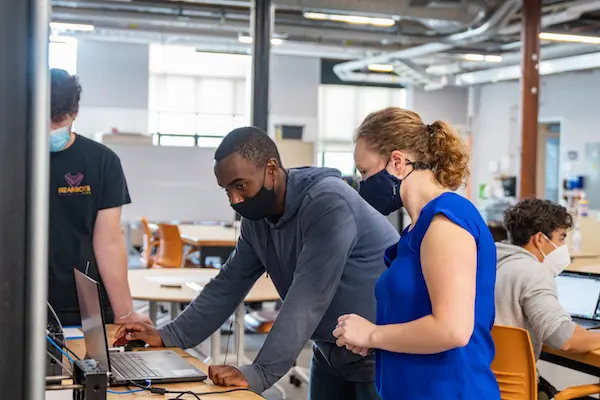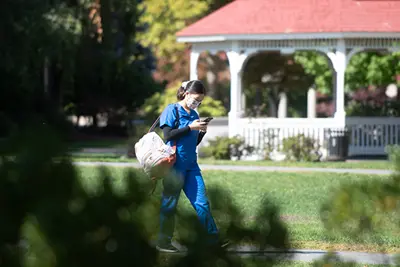Facilities Management Monitors Air Flow to Help Stem Spread of COVID-19
 Image by Tory Wesnofske
Image by Tory Wesnofske
Facilities Management remotely monitors building ventilation systems to keep the air safe for students and faculty, such as in this Intro to Mechanical Engineering lab.
10/29/2020
By Ed Brennen
The air in most of those rooms is exchanged at least six times an hour, passing through filters with a minimum efficiency reporting value (MERV) of 13 or better, which meets the standards set by the American Society of Heating, Refrigerating and Air-Conditioning Engineers (ASHRAE).
And it’s all closely monitored by Facilities Management staff on the university’s centralized building management system, Automated Logic.
“Having that centralized, automated control over the campus spaces allows us to make sure our buildings are as safe as they can possibly be,” says Assoc. Vice Chancellor for Facilities Management and Planning Jean Robinson.
As the university looks to hold more in-person classes and increase the number of students living on campus next semester, Facilities Management is maximizing the technological capabilities of its building management and heating, ventilation and air-conditioning (HVAC) systems to help prevent the possible spread of COVID-19.
Video by Alfonso Velasquez
A look at the resilience of students and faculty in the 'new normal' on campus.
“Safety is on everyone’s mind, and we are so grateful for the important work that you are doing to come up with these strategies for the campus,” Chancellor Jacquie Moloney told Facilities Management staff during a recent visit to thank them for their efforts.
Automated Logic monitors nearly 45,000 “control points” in 90 percent of buildings across campus, according to Assoc. Director of Mechanical, Electrical and Plumbing Operations Randy Branson. Control points can be as large as a classroom, office or dorm room, or as small as a heating valve, return fan or lab hood.
After the coronavirus pandemic shut down campus last spring, Building Energy Management System Technician James Santangelo spent nearly a month reprogramming the building ventilation systems to allow dampers to bring in 100 percent outside air — all with the push of a button. Normally, HVAC systems bring in 10 to 20 percent outside air.
By coordinating with the Registrar’s Office and using the Campus Viewer platform, Facilities Management can see which classrooms and labs are in use each day — and then program the HVAC system to fully open the dampers two hours before and after the space is occupied.
Bringing in outdoor air is easier when it’s warm outside, but Branson and Santangelo note that the system can remain fully open until the temperature drops to about 25 degrees Fahrenheit. At that point, it will have to be dialed back to around 75 percent to keep spaces comfortable.
 Image by Ed Brennen
Image by Ed Brennen
Chancellor Jacquie Moloney, right, and Assoc. Vice Chancellor for Facilities Management and Planning Jean Robinson listen to a presentation on the university's building management system during the chancellor's recent visit with Facilities staff members.
But even if the system was recirculating 50 percent indoor air, Branson says the dilution rate of airborne particles — combined with the wearing of face coverings and limiting the number of people in a room with social distancing — would likely be sufficient.
While air is exchanged in rooms several times an hour as recommended by ASHRAE, Branson notes that increasing the frequency of air changes would actually disrupt the balance that HVAC systems are designed to strike between supply air and return air.
“That actually increases the air turbulence,” says Branson, who is on frequent Zoom meetings with the Centers for Disease Control and ASHRAE to ensure the university is meeting air quality standards. “So if you cough, it takes those droplets and spreads them throughout the room more.”
Facilities Management has installed the largest filters that will fit into each building for maximum effectiveness. Newer buildings on campus, such as University Crossing and the Health and Social Sciences Building, have MERV 14 air filters, which exceed CDC recommendations and catch 90 percent of particles as small as 3 microns in size (a respiratory droplet is between 5 and 10 microns). Other buildings on campus use MERV 13 filters, which catch more than 75 percent of particles in the 3 to 10 micron range.
Branson says the HVAC systems have two filters — a pre-filter that is changed twice a year and a secondary filter that is changed every 18 months.
At the Campus Recreation Center, meanwhile, hospital-grade MERV 16 filters that catch 99 percent of smaller, respiratory particles were installed earlier this year when the building was converted to a field hospital for Lowell General — which was never used.
 Image by Tory Wesnofske
Image by Tory Wesnofske
A student picks up food from a dining services staff member at the University Dining Commons at Fox Hall.
In addition to controlling air quality in campus buildings, Automated Logic allows Facilities Management to monitor energy usage and reduce consumption during demand response events, sustaining resources and saving the university money. Using this automated control to ramp down the mechanical systems during the low-occupancy period of July and August saved the campus $400,000 during that two-month period alone.
“I’ve installed and worked on numerous building management systems across New England in my 16-year career, and this is the most advanced system I’ve ever seen,” says Santangelo, who joined UML seven years ago from Northeastern University.
“The investment the university has made into this system and its buildings over the years is really paying off when it comes to our carbon footprint,” adds T.J. McCarthy, executive director of Operations and Services. “And it allows us to make sure people are comfortable and safe.”




